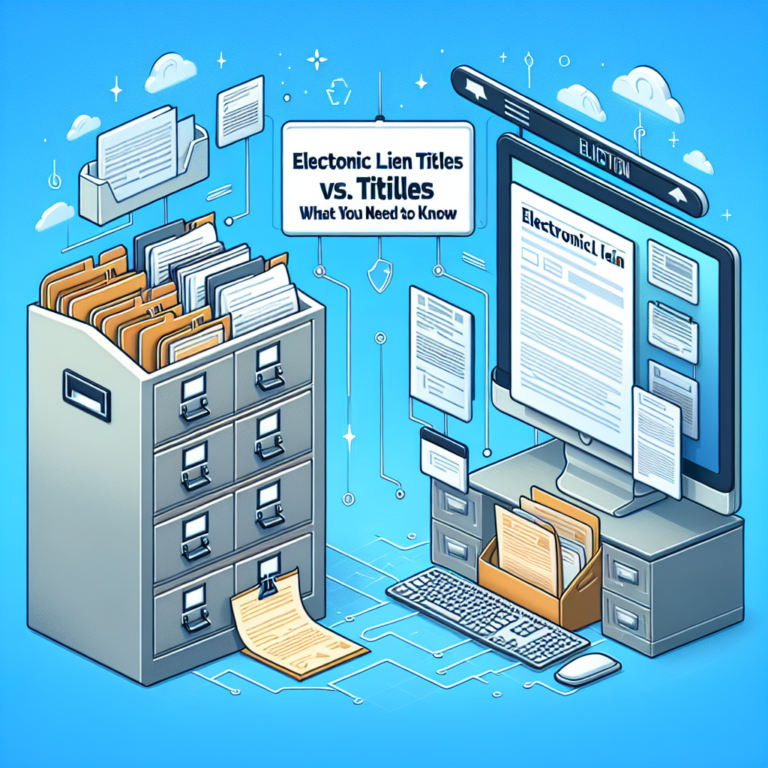In an age where digital technology is transforming nearly every aspect of our lives, the way we manage vehicle ownership and financing is no exception. Traditionally, vehicle titles—documents that establish ownership—were paper-based, often laden with the challenges of physical storage, manual processing, and risk of loss or damage. However, the advent of Electronic Lien Titles (ELTs) is reshaping this landscape. Below, we delve into the differences between electronic lien titles and traditional titles, their benefits and drawbacks, and what you need to know if you’re navigating vehicle ownership or financing.
Understanding Vehicle Titles
Before exploring the differences, it’s important to understand what vehicle titles are and why they matter. A vehicle title is a legal document issued by a state agency that outlines who owns a vehicle and includes important information like the vehicle identification number (VIN), make, model, and year. When vehicles are financed or leased, a lien is placed on the title to protect the lender’s interest until the debt is fully paid.
Traditional Titles
Traditional vehicle titles are physical documents printed on paper. They are issued by state motor vehicle departments and must be signed and physically transferred when ownership changes. For financed vehicles, if the borrower fails to make payments, the lender can repo the vehicle, but this is often a lengthy process that requires manual tracking and documentation.
Benefits of Traditional Titles:
- Tangible Document: For many, having a physical document provides a sense of security and ownership.
- Less Technology Dependent: Traditional titles don’t require internet access or technology literacy, making them more accessible in certain populations.
- Familiarity: Many people are accustomed to the process of dealing with paper titles, making the transition to ELTs seem daunting.
Drawbacks of Traditional Titles:
- Risk of Loss or Damage: Paper titles can be misplaced or damaged, complicating ownership verification.
- Manual Processing: The transfer of ownership typically requires physical signatures and in-person visits to the DMV.
- Inefficiency: The time it takes to process and mail paper titles can delay transactions and lead to administrative burdens.
Electronic Lien Titles (ELTs)
Electronic Lien Titles represent a modern approach to vehicle ownership tracking. With ELTs, titles are stored electronically in a secure database maintained by state motor vehicle agencies. When a lien is placed on a vehicle, it is registered digitally, allowing all parties involved—borrower, lender, and DMV—to view and manage the title online.
Benefits of ELTs:
- Efficiency: Electronic processing reduces the time needed for title updates and transfers. Transactions can often happen in real-time.
- Reduced Risk: Since they are stored in a secure database, ELTs mitigate the risk of loss, theft, or damage associated with paper titles.
- Streamlined Processes: Lenders and borrowers can manage their liens and titles online, simplifying communication and documentation.
- Enhanced Security: Electronic systems can employ advanced security measures, making title fraud more difficult.
Drawbacks of ELTs:
- Technology Reliance: Both parties must have access to the internet and the necessary technology, which can be a barrier for some.
- Transition Period: As states move from traditional to electronic systems, there can be confusion or delays in processes during the transition.
- Learning Curve: For those unfamiliar with digital systems, navigating ELT processes can be challenging.
Key Considerations
As states increasingly adopt electronic lien title systems, here’s what to keep in mind:
-
Know Your State’s Regulations: The adoption of ELTs varies by state, so familiarize yourself with the specific regulations and processes in your jurisdiction.
-
Work with Reputable Lenders: If you’re financing a vehicle, work with lenders familiar with ELT processes to ensure a smooth experience.
-
Ask Questions: If you’re not comfortable with digital systems, don’t hesitate to ask about the processes. Understanding how your title will be managed can alleviate concerns.
-
Maintain Records: Even with electronic titles, it’s wise to keep personal copies of any title documents and lien-release forms.
- Monitor Your Title Status: Most state DMV systems allow you to check the status of your title electronically. Keep an eye on it to ensure everything is up-to-date.
Conclusion
In summary, both Electronic Lien Titles and traditional titles have their strengths and weaknesses. As technology continues to advance, the benefits of electronic systems, including efficiency and security, may outweigh the familiarity and tangibility of traditional paper titles. For vehicle owners and lenders alike, understanding these differences and adapting to the evolving landscape of title management is crucial for ensuring a smooth and secure vehicle ownership experience. Whether you’re purchasing, leasing, or financing a vehicle, being informed about your options will empower you to make the best decision for your circumstances.


